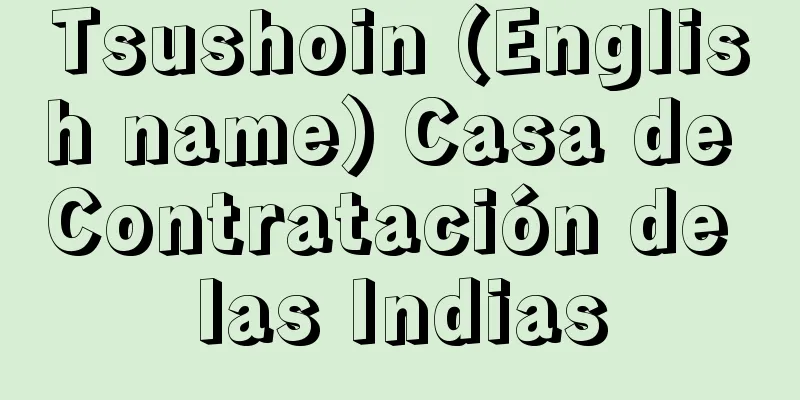Kuni no Miyatsuko

|
A local powerful clan and local official under the ancient clan and surname system. It corresponds to Tomo no Miyatsuko. There is a theory that a kuniken system was established in the 6th and 7th centuries with kuni no Miyatsuko at the top and agatsu no Shi at the bottom, but it is believed that when the monarchical system of shi, which was positioned as local officials under the early Yamato government, weakened, a new administrative area called "kuni" was established in response to the progress of the unified control of the Yamato state, and the most powerful powerful clan in that region was positioned as kuni no Miyatsuko, the chief. In the mid-7th century, the Taika Reforms changed the local system to the ryo system of kuni and gun (Hyo) system, and kuni no Miyatsuko became Kori no Miyatsuko (Hyo). The duties of the kuni no miyatsuko were to govern the kuni no miyatsuko provinces, and included having their children serve the central government as toneri and uneme, managing the bemin and miyake, providing tribute in the form of horses, weapons and other items, and providing military strength. Eventually, they were established from southern Miyagi Prefecture and northern Niigata Prefecture in the north to Kyushu, Iki and Tsushima in the south, totalling over a hundred. The kuni no miyatsuko's characteristic surname was atai, but there were also omi, kimi and a few muraji and miyatsuko. Many of their powers originally grew as the heads of small local provinces, and so they also had strong roles as chief priests in their regions. This character was conveyed around 676 (the 5th year of Emperor Tenmu's reign) when the Ritsuryo province system was institutionalized with one local Shinto official, the Ritsuryo kokujin (new kokujin). [Naokichi Niino] "Kuni no miyatsuko and Kenshu" by Niino Naokichi (1965, Shibundo)" ▽ "Kuni no miyatsuko: A research history (1974, Yoshikawa Kobunkan)" ▽ "The mysterious kuni no miyatsuko" by Niino Naokichi (1975, Gakuseisha)" ▽ "Collection of historical materials relating to kuni no miyatsuko and Kenshu" edited by Saeki Ariyoshi and Takashima Hiroshi (1982, Kondo Publishing)" Source: Shogakukan Encyclopedia Nipponica About Encyclopedia Nipponica Information | Legend |
|
古代氏姓制度下の地方豪族、地方官。伴造(とものみやつこ)に対応する。6、7世紀に国造が上で県主(あがたぬし)が下の国県制設定を考える説もあるが、初期大和(やまと)政権のもとに地方官として位置づけられていた君長的な県主制が機能を弱めてきたとき、大和国家の国土統一支配の進展に対応して新たに「国」という行政圏が設定され、その地方のもっとも有力な豪族が長官の国造として位置づけられたものと認められる。7世紀なかば大化改新により地方制度が令(りょう)制の国郡(くにこおり)(評)制に切り替えられ、国造は郡領(こおりのみやつこ)(評造)になる。国造の職掌は、国造国の支配で、子女を舎人(とねり)や采女(うねめ)として中央に出仕させること、部民(べみん)や屯倉(みやけ)を管理すること、馬や兵器など物品を貢納すること、軍事力を負担することなどの任務ももっていた。最終的には、北は宮城県南部、新潟県北部から、南は九州、壱岐(いき)、対馬(つしま)まで置かれ、総計百数十に達した。国造に特徴的な姓(かばね)は直(あたい)であるが、臣(おみ)、公(きみ)や若干の連(むらじ)や造(みやつこ)もあった。もともと地方小国家の君長として成長した勢力が多いので、地域における祭主的性格も強かった。その性格は、676年(天武天皇5)ごろ、令制一国に一員の地方神祇(じんぎ)官、律令国造(新国造)が制度化されることによって伝えられた。 [新野直吉] 『新野直吉著『国造と県主』(1965・至文堂)』▽『新野直吉著『研究史 国造』(1974・吉川弘文館)』▽『新野直吉著『謎の国造』(1975・学生社)』▽『佐伯有清・高嶋弘志校訂『国造・県主関係史料集』(1982・近藤出版社)』 出典 小学館 日本大百科全書(ニッポニカ)日本大百科全書(ニッポニカ)について 情報 | 凡例 |
<<: Doctor of Country - Doctor of Country
Recommend
Magazzino
… [Kirisiki Shinjiro] [Early Modern Warehouses an...
Tetoron
(Tetoron) Trademark name of polyester synthetic fi...
Kawarasuzu - Kawarasuzu
An insect belonging to the family Gryllidae in th...
Key signature - English
A type of accidental used in staff notation to in...
Zaandam (English spelling)
This was an old industrial area in the province of...
Funabashi [city] - Funabashi
A city in northwestern Chiba Prefecture. It was in...
Tafel's equation
...In particular, the relationship between activa...
Mine hunter (English spelling) minehunter
…Minesweepers are classified according to their s...
Kagami-biraki (opening of a sake barrel)
This is a ceremony in which New Year's Kagami...
Catamaran - Soudousen
A ship with two hulls arranged in parallel and co...
Arasa
…Until the Meiji period, it belonged to Hyuga Pro...
Front room - Omotezasiki
〘noun〙① A room located at the front of a house. Us...
Euler function - oiler function
…When m = 6, 1,5 is an irreducible coset. The fun...
Infighting - Infighting
...A sport in which opponents wearing gloves on b...
Street car - romendensha (English spelling)
A streetcar that runs on public roads, not on a d...









